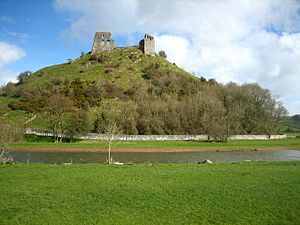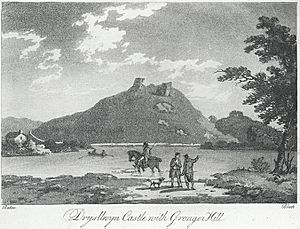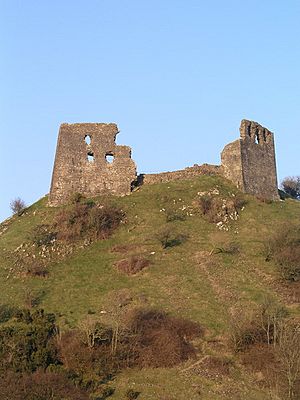Dryslwyn Castle facts for kids
Drysllwyn Castle (which means Castell y Drysllwyn in Welsh) is an old Welsh castle. It sits on a rocky hill in Wales, between the towns of Llandeilo and Carmarthen. From its high spot, you can see amazing views of the Tywi Valley.
This castle was built around the 1220s by one of the Welsh princes from a kingdom called Deheubarth. Over many years, the castle was fought over and changed hands several times between the Welsh and the English. It's special because it's one of the most important castles still standing that was built by a Welsh leader. It's also a Grade I listed building, meaning it's very important historically.
Contents
A Castle for Welsh Princes
Drysllwyn Castle is built on an isolated, rocky hill high above the Towy Valley. This made it a fantastic place for defense! Some people think there might have been an older fort here from prehistoric times, but there's no proof of that yet.
In the 1100s, a powerful Welsh leader named Rhys ap Gruffydd, also known as "Lord Rhys," ruled the kingdom of Deheubarth. He brought a time of peace and stability to the area. After he died in 1197, his three sons started fighting over who would inherit his land. This fighting made it easier for neighboring Welsh kingdoms and the English to move into Deheubarth. Drysllwyn Castle was built around this time.
We don't know exactly who built Drysllwyn Castle, but it was probably one of the princes of Deheubarth in the 1220s. Maybe it was Rhys Gryg. Whatever the case, Drysllwyn Castle, along with nearby Dinefwr Castle, was very important for protecting the kingdom.
In 1246, an old book called Annales Cambrie mentioned a siege of the castle. A "Seneschal of Carmarthen" (a kind of manager or governor) attacked it. He said he was acting for the castle's "rightful owner," but we don't know who that was or if the attack worked. It's possible that Rhys Gryg built both Drysllwyn and Dinefwr castles for his two sons after he died in 1234. The two castles look very similar. They both had a round tower with a wide base inside a wall that followed the shape of the hill. Inside the walls, there was a great hall and another building that was probably a kitchen. There was also a small enclosed area that might have been a prison.
The English Takeover
The castle was made much bigger and stronger in the late 1200s. After the last native prince of Wales, Dafydd ap Gruffydd, died in 1283, Drysllwyn was one of the few strong stone castles in Wales still held by a Welshman. The most important Welsh lord left, Rhys ap Maredudd, kept making the castle's defenses even better. The English allowed him to keep his castle because he seemed more willing to cooperate with them than other Welsh lords.
However, in 1287, Rhys rebelled against English rule. King Edward I sent his army, about 11,000 soldiers, to attack the castle. They used a large siege weapon called a trebuchet and dug tunnels under the castle walls to make them collapse. This siege lasted three weeks. Sadly, some English knights died when one of their tunnels collapsed while they were checking it. Rhys's rebellion ended the next year, and he was captured and executed in 1292.
Castle's Final Days
In the summer of 1403, Owain Glyndŵr, another famous Welsh rebel leader, captured Drysllwyn Castle. When the English forces took it back, they made sure it couldn't be used again. They blocked entrances, walled up the gatehouse, removed steps from stone stairs, and even took the hinges off the main gate. Later, all the main buildings were burned down. After that, much of the stone from the castle was taken away and used for other things.
What's Left of Drysllwyn Castle
The castle's limestone walls were built in the 1220s. It was carefully taken apart in the early 1400s. This was probably done to stop Welsh rebels from using it again.
Today, not much of the original castle is left. Most of what you can see now has been uncovered by archaeologists digging there. Some small parts of the Middle and Outer Walls are still standing, mostly near the Middle and Outer Gates. The best-preserved parts are inside the Inner Ward. Here, you can see how the castle was built in a many-sided shape to fit the hilltop.
Drysllwyn Castle is considered one of the most important remaining castles built by a Welsh chieftain. It's also special because it's the only native Welsh castle known to have three separate defensive areas, called "wards." It is a Grade I listed building.
Images for kids







